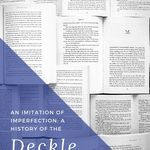A post shared by St Cuthberts Mill (@st_cuthberts_mill) on Apr 12, 2019 at 11:07am PDT These edges are a natural result of making paper by hand, but most of the books on your shelf with irregular edges are an artificial simulation of true deckle edges. Why do modern printers imitate a defect of earlier printing processes? To see how we got there, we’ll go on a brief journey through the history of papermaking. Papermaking began in China during the Eastern Han Period (25–220 CE), where it began to spread through Asia. In Japan, a deckle was added, which is a frame that fits inside of the papermaking mould. By the 11th century, this process traveled to Europe: in fact, the original papermaking moulds in Europe were likely still made of bamboo! (Papermaking: The History and Technique of an Ancient Craft by Dard Hunter)
A post shared by Angelita Teo (@angelitateo) on Sep 5, 2019 at 6:32am PDT The deckle doesn’t seal perfectly into the mould, which means that as the slurry of pulp and water sits in the mould, some gets trapped under the edges of the deckle. This is what creates the “deckle edge.” In Japan and China, these edges were trimmed off. When it was brought over to Europe, deckle edges were also unlikely to survive the binding process. If they weren’t cut off by the paper maker, they were usually trimmed by the binder. Some binders were so zealous about this that book were left with almost no margins at all.
A post shared by @ juca_designs on Jun 4, 2018 at 5:14pm PDT By the 17th century, book collecting had gained popularity in Europe. Where the deckle edge had previously been seen as a defect, collectors began to seek them out at this point. Trimmed edges were a red flag that a book may have been rebound, and could have been trimmed too far. A deckle edge was a sign of a pristine, original binding—or at least a sympathetic one (The Book by Keith Houston).
A post shared by Addyman Books (@addymanbooks) on Feb 17, 2017 at 4:09pm PST In Dard Hunter’s Papermaking: The History and Technique of an Ancient Craft, he says (somewhat judgmentally) “During the early years of printing in Europe the deckle edges on paper were looked upon with disdain. Now these some rough edges are the label of respectability and recall to mind private presses, limited editions, and all manner of book snobbery.” He is appalled by the rise of artificial deckle edges on machine made paper, calling it “an imitation of an imperfection.” Once an unsightly defect, then a mark of the handmade, now deckle edges are usually artificially created with sandblasting, sawing, or tearing (Houston).
A post shared by katie • kentucky (@steelepages) on Aug 25, 2019 at 4:23am PDT True deckle edges still exist. They’re the hallmark of handmade paper: in fact, according to Hunter, only a handful of bibliophiles would able to distinguish handmade paper from machine paper if it weren’t for the deckle edge. Handmade paper is an art form, and I highly recommend trawling through instagram looking at some of the incredible work being done.
A post shared by A n n a b e l K e a t l e y (@annabel_keatley) on Sep 17, 2019 at 1:23pm PDT There are still people continuing the papermaking process in much the same way that is was done thousands of years ago.
A post shared by DRUCKGRAFISCHES ATELIER (@druckgrafisches_atelier) on Sep 13, 2019 at 12:34am PDT Deckle edges were created from an imperfect, handmade process. Nowadays, machine-made paper can be precise and efficient: no ragged or feathered edges needed. I think it says something about the ridiculousness and loveliness of humans that we have nostalgia for these cosmetic defects, enough that we have machines produce replicas of them. Deckle edges continue to be controversial, but diving into the history of papermaking has made me better appreciate this peculiarity of books.
A post shared by FIBERHOUSE COLLECTIVE (@fiberhousecollective) on Sep 15, 2019 at 5:58am PDT
Books Mentioned
The Book: A Cover-to-Cover Exploration of the Most Powerful Object of Our Time by Keith Houston (If you want to read an exploration of the book as an object, pick this one up!) Papermaking: The History and Technique of an Ancient Craft by Dard Hunter (If you want to learn more about papermaking, including the history, this is a must read!)
A post shared by Craft Draft (@craft.draft.fez) on May 10, 2018 at 5:01am PDT
